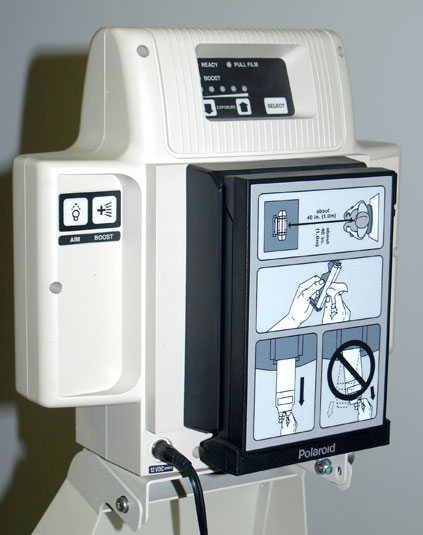The Steps
parts & labor
what's needed to get the job done
basics of function
how does the camera usually operate; what parts do what and go where
the back, the strap, the flash
taking off useless vintage roll-film parts
the rangefinder
removing, taking apart and cleaning
cutter-bar & inner parts
more useless vintage parts that have to go
ready the donor
removal of all nonessential parts from a packfilm donor
hack to pieces
make the back fit
odds n' ends
tidying up; side door
putting it all together
replace rangefinder, fix flash; paint
reset infinity
setting the focus stop
Parts & Labor
To start with, you will of course need a useless vintage Polaroid camera. Preferably one that does NOT have a riveted in place focus stop.To keep it simple, Models 110, 110A/B, 120, 150, 160 or 800 have adjustable ones. (I later found mine to be a rare 150 that is riveted)
Next you will need a donor camera. ANY of the bazillion 100/600 series packfilm cameras can be a potential donor. It all depends on what you can get your hands on, and a little on personal preference. Some involve actual cutting and drilling, others a couple of screws. If you want to keep it even more simple, you can find a Polaroid packfilm back, sometimes called the CB-103, it is typically found on the back of many scientific, dental, passport and ID cameras. In any case, you need a packfilm back.
I chose to use the back from an Automatic 104. Extremely common, and cheap enough that I don't mind breaking it. Which could potentially happen, as the back we need is actually part of the entire camera body. One need to not only cut, but also drill out numerous rivets.
The best tool for this entire project, besides the mass of meat behind your eyes, is a rotary tool. Most commonly referred to by a brand name, Dremel. If you don't own one, no big deal, everything can be done with saws, files, sandpaper and some creativity. Like many things I buy, I justified purchasing a Dremel tool knowing it will be useful for a long time to come. In my opinion, if you don't own one, this project is a good excuse to finally get one. You will need some cut-off wheels, some grinding bits, and some small drill bits.
Screwdrivers will, of course, be needed. Mostly you will need smaller screwdrivers than you may own. Electronic and computer repair types are best. Interestingly, you will find both flat and Philips head screws on your Polaroids. The flat screwdrivers also come in handy for some prying. But, perhaps the best tool for some parts of the job is a plain ol' pair of needle-nose pliers. If you have really narrow pliers, all the better.
